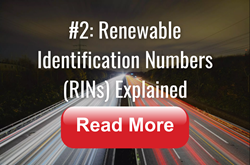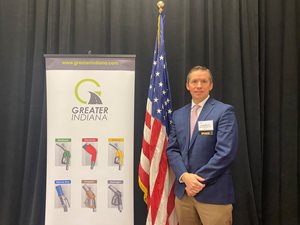Both Kinder Morgan RNG and the renewable natural gas (RNG) industry had an exciting 2023. From new project developments and a rebranding to regulatory shifts and technological advancements, we’ve continued to experience how dynamic the RNG industry can be.
As the world continues to increase its focus on reducing emissions, governments, communities and corporations are making commitments to building a more sustainable future. At Kinder Morgan RNG, we are dedicated to helping achieve these goals through our continued focus and development of RNG. Our progress in 2023 has been a testament to our commitment to accelerating the energy transition and we look forward to continuing to contribute to our vision of delivering energy to improve lives and create a better world.
2023: The Year of Kinder Morgan RNG
A Growing RNG Portfolio:
In 2023, we completed two RNG plants and continue to make progress on a third in Indiana. Once completed, these projects will add a combined annual RNG generation capacity of approximately 3.9 billion cubic feet (Bcf).



Innovation & Insights
In addition to our innovative RNG solutions, we deliver insights and education to help landfills convert biogas to RNG and to assist organizations in their transition to renewable energy. These were our top blog posts of 2023:
In addition to our innovative RNG solutions, we deliver insights and education to help landfills convert biogas to RNG and to assist organizations in their transition to renewable energy. These were our top blog posts of 2023:



This summer, we released “Making the Greatest Impact with Your Biogas,” a guide for landfill leadership teams interested in learning more about RNG and how their landfill can contribute to the growing demand for RNG. Learn more about “Making the Greatest Impact with Your Biogas” here.
This fall, we underwent a rebrand and transitioned to Kinder Morgan RNG. This transformation underscores our scale and synergy across Kinder Morgan, and further reinforces our position as a leader within the RNG industry. The decision to rebrand also reflects our dedication to fostering innovation, sustainability and leadership in this dynamic industry.


The Renewable Fuel Standard Update
The regulatory landscape continued to shift in 2023 with an update to the Renewable Fuel Standard (RFS). The 2023 changes aim to continue driving the transition to lower-carbon energy solutions and enable greater RNG development and adoption. One significant update was an increase to the renewable volume obligations (RVOs). The updated ruling increased renewable volume obligations for cellulosic biofuel to 0.84 billion gallons in 2023, 1.09 billion gallons in 2024 and 1.38 billion gallons in 2025.1
Additionally, the Environmental Protection Agency (EPA) originally proposed incorporating electric renewable identification numbers (eRINs) into the RFS in 2023, which aimed to increase the use of RNG in the transportation sector for electric vehicles. The proposal detailed how eRINs could potentially bring down the total cost of producing electric vehicles, incentivize manufacturers to broaden their product lines and share revenue between suppliers. The EPA then paused the eRINs proposal1 shortly before releasing the RFS in July. As this would have been a major addition to the program, and the processes were substantially different than the current rules and regulations around RINs, this proposal was met with extensive comments. The EPA determined they would not be able to appropriately address every concern and decided to drop the addition ahead of the final ruling. This doesn’t mean there won’t be a proposal regarding eRINs in the future though – we could see a revised proposal as early as June 2024.1
Utilities: Powering a Cleaner Future with RNG
RNG has seen increased adoption among utilities, thanks to more than 30 states creating energy efficiency policies designed to lower the growth of consumption of conventional natural gas.2 These policies vary: some states have mandates, like in Michigan, where they will require utility providers to transition to 100% carbon-free energy generation by 2040.3 Many states have set renewable standards or targets. These policies have led to increased interest and adoption of RNG. When pairing these renewable policies for utilities with the increase in demand from the trucking industry and corporations working to reduce their emissions, the demand for RNG continues to trend upwards.
Transportation: The Road to Reduced Emissions
There are more than 175,000 natural gas vehicles (NGVs) RNG continues to see increased adoption across the transportation space as more trucking companies announce and implement natural gas fleets. This trend is likely to continue as new technology becomes available. Earlier this year, Cummins Inc. announced their newest natural gas engine, the X15N. This is a major milestone for the RNG industry as it will enable more trucking companies to convert their fleets from diesel to RNG. The X15N engine is a natural gas engine designed for heavy-duty and on-highway truck applications. It has 400-500 horsepower and can travel 750 miles and offers a 10% fuel economy improvement compared to its predecessor, the ISX12N.4
Landfills: Prime Position to Accelerate Energy Transition
The number of organizations shifting to RNG continues to expand and landfills have a tremendous opportunity to be a part of the RNG industry’s growth. By partnering with an RNG developer to upgrade their landfill gas to produce RNG, landfills are experiencing increased revenue, reduced emissions and enhanced community relations. These landfills experience less odor complaintsand can positively contribute to their communities using the extra revenue coming from RNG production.
The EPA has prioritized the landfill sector as an industry to reduce greenhouse gas emissions and has stated that it will “conduct unannounced inspections of suspected non-compliant facilities” so that communities don’t suffer from poor air quality and odors.5 By implementing a landfill RNG project, not only can landfills reduce emissions, they can be a part of the solution in transitioning to renewable energy sources.
Are you a landfill owner or operator ready to experience the benefits of an RNG plant? Let’s have a conversation.



2023 has been a year of transformation and accomplishment for us. With the successful completion of additional RNG plants, a strategic rebrand and the reinforcement of our position as a leader in the RNG space, we continue to solidify our commitment to helping organizations reduce emissions. Here’s to a remarkable year of Kinder Morgan RNG and to an exciting future.
Sources

In December, Kinder Morgan RNG Vice President and Chief Commercial Officer Craig Moore spoke at the 2023 Indiana Environmental Conference & Winter Technical Meeting. These sessions focused on how the transportation industry can use RNG and contribute to a sustainable future.

2023: Dynamics & Tailwinds
The Renewable Fuel Standard Update
The regulatory landscape continued to shift in 2023 with an update to the Renewable Fuel Standard (RFS). The 2023 changes aim to continue driving the transition to lower-carbon energy solutions and enable greater RNG development and adoption. One significant update was an increase to the renewable volume obligations (RVOs). The updated ruling increased renewable volume obligations for cellulosic biofuel to 0.84 billion gallons in 2023, 1.09 billion gallons in 2024 and 1.38 billion gallons in 2025.1
Additionally, the Environmental Protection Agency (EPA) originally proposed incorporating electric renewable identification numbers (eRINs) into the RFS in 2023, which aimed to increase the use of RNG in the transportation sector for electric vehicles. The proposal detailed how eRINs could potentially bring down the total cost of producing electric vehicles, incentivize manufacturers to broaden their product lines and share revenue between suppliers. The EPA then paused the eRINs proposal1 shortly before releasing the RFS in July. As this would have been a major addition to the program, and the processes were substantially different than the current rules and regulations around RINs, this proposal was met with extensive comments. The EPA determined they would not be able to appropriately address every concern and decided to drop the addition ahead of the final ruling. This doesn’t mean there won’t be a proposal regarding eRINs in the future though – we could see a revised proposal as early as June 2024.1
Utilities: Powering a Cleaner Future with RNG
RNG has seen increased adoption among utilities, thanks to more than 30 states creating energy efficiency policies designed to lower the growth of consumption of conventional natural gas.2 These policies vary: some states have mandates, like in Michigan, where they will require utility providers to transition to 100% carbon-free energy generation by 2040.3 Many states have set renewable standards or targets. These policies have led to increased interest and adoption of RNG. When pairing these renewable policies for utilities with the increase in demand from the trucking industry and corporations working to reduce their emissions, the demand for RNG continues to trend upwards.
Transportation: The Road to Reduced Emissions
There are more than 175,000 natural gas vehicles (NGVs) RNG continues to see increased adoption across the transportation space as more trucking companies announce and implement natural gas fleets. This trend is likely to continue as new technology becomes available. Earlier this year, Cummins Inc. announced their newest natural gas engine, the X15N. This is a major milestone for the RNG industry as it will enable more trucking companies to convert their fleets from diesel to RNG. The X15N engine is a natural gas engine designed for heavy-duty and on-highway truck applications. It has 400-500 horsepower and can travel 750 miles and offers a 10% fuel economy improvement compared to its predecessor, the ISX12N.4
Landfills: Prime Position to Accelerate Energy Transition
The number of organizations shifting to RNG continues to expand and landfills have a tremendous opportunity to be a part of the RNG industry’s growth. By partnering with an RNG developer to upgrade their landfill gas to produce RNG, landfills are experiencing increased revenue, reduced emissions and enhanced community relations. These landfills experience less odor complaintsand can positively contribute to their communities using the extra revenue coming from RNG production.
The EPA has prioritized the landfill sector as an industry to reduce greenhouse gas emissions and has stated that it will “conduct unannounced inspections of suspected non-compliant facilities” so that communities don’t suffer from poor air quality and odors.5 By implementing a landfill RNG project, not only can landfills reduce emissions, they can be a part of the solution in transitioning to renewable energy sources.
Are you a landfill owner or operator ready to experience the benefits of an RNG plant? Let’s have a conversation.



Moving Forward
2023 has been a year of transformation and accomplishment for us. With the successful completion of additional RNG plants, a strategic rebrand and the reinforcement of our position as a leader in the RNG space, we continue to solidify our commitment to helping organizations reduce emissions. Here’s to a remarkable year of Kinder Morgan RNG and to an exciting future.
Sources
- Flash Report: EPA Finalizes RVOs for 2023, 2024, and 2025; Drops Proposed eRIN Provisions - Stillwater Associates
- States Lose the Carbon and Work on Cleaner, On-Demand Energy Habits - National Conference of State Legislatures (ncsl.org)
- Michigan will implement ambitious clean energy mandates with goal of carbon-free electricity by 2040 | PBS NewsHour
- Cummins' 15-Liter Natural Gas Engine in Customer Testing | Transport Topics (ttnews.com)
- EPA Administrator Regan Announces Bold Actions to Protect Communities Following the Journey to Justice Tour | US EPA


